Category Archives: News
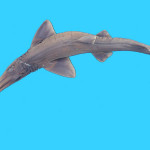
New species of saw shark – Pristiophorus lanae – Lana’s Sawshark
This isnt really aquarium related but if you are anything like me than you will get excited whenever you see a new sawfish or shark. With this is mind this is perfect. A new Species of sawshark have been discovered and scientifically described. The new species will be known as Pristiophorus lanae and can be found in the western North Pacific. Continue reading
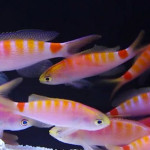
Watch video of new Caledonia Sunrise Anthias
The New Caledonia Sunrise Anthias is a stunning new species that we recently wrote about here. The species is allready being collected and can be purchased in the United states through Quality Marine. Quality Marine is bringing in a decent number of these stunning fish and you should be able to pick up a group of them at a decent price.
The clip below will tell you more about this species, how it was discovered and will let you see it in both the wild and in an aquarium environment:
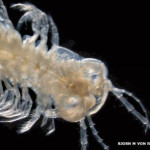
New venomous remipede species discovered, Speleonectes tulumensis
A new venomous species of remipede, Speleonectes tulumensis, has been found and described by science. The new species is the first venomous crustacean and have a venom similar to that found in rattlesnakes.
The new species of remipede seems to have a wide distribution and has been observed in underwater caves located in the Caribbean sea, around the Canary Islands, and off Western Australia. Further research might reveal that this is actually several very similar species.
The species is blind and found in dark caves.
The remipede use its venom to hunt and kill its prey. They mainly feed on other crustaceans. The venom kills the prey and liquifies the soft tissue allowing the remipede to consume it by sucking it out of its prey much like a spider do on land.
Dr Ronald Jenner, a zoologist at London’s Natural History Museum and a co author of the research paper introducing the remipede comments on the discovery by saying:
“The unique insights from this study really help improve our understanding of the evolution of animal venoms.
The spider-like feeding technique of the remipede is unique among crustaceans. This venom is clearly a great adaptation for these blind cave-dwellers that live in nutrient-poor underwater caves.” ..
The discovery was made of a team of scientists consisting of
- Björn M. von Reumont
- Alexander Blanke,
- Sandy Richter,
- Fernando Alvarez,
- Christoph Bleidorn,
- Ronald A. Jenner
and was presented in the research article:
The first venomous crustacean revealed by transcriptomics and functional morphology: remipede venom glands express a unique toxin cocktail dominated by enzymes and a neurotoxin
Mol Biol Evol (2013) doi: 10.1093/molbev/mst199
If you want to know more you can find the research paper in the Oxford journal of Molecular Biology and Evolution.
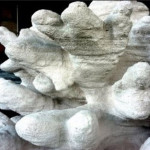
3D printing set to revolutionize artificial reefs
Making reef structures from cement has long been used as a technique to try to restore or create new reefs. The cement reefs do work but are associated with several different problems. One of them is that cement isn’t pH neutral and that coral larvae therefore do not settle on them in the amounts that is desired. Another method used to create fake reef is to use metal structures with a low electric current running through them. This quickly calcifies the tubes and promote coral growth. This method can however be expensive and requires access to electricity. This can be hard to provide in areas where solar cells are likely to be stolen by local fishermen..
SOI, 3D program specialist James Gardiner and Reef Arabia is now pioneering a new method of creating artificial reefs that might turn out to be a better alternative. Using a 3D printer to print reefs. They have developed a 3d printer than can print out reefs in a sand stone material. They have allready made and submersed two reefs. There are many benefits with this process says the forum group.
- The sand stone is pH neutral.
- It is possible to print any form with ease. This allows for more vertical surfaces where coral larvae like to attach themselves.
- A lot more complex designs are possible. 3D printing can easily create caves, crevices and other complex forms that would not be possible to do in cement.
- It is easy to use different designs which allows to create a lot more complex reefs (using different designed pieces). A more complex reef will offer suitable living space for more species.
- Sand stone has a smaller eco footprint than concrete as a lot less co2 is released in process.
- 3D printing can allow for more rapid production of artificial reef. At this point it takes 1 day to print one 5m reef unit and 4 of those can be printed simultaneous. A complex reef structure take about 1 week to design in the computer
It is still not certain that this technique will prove to be quicker and more cost efficient than currently used methods of creating reefs but Reef Arabia remain optimistic and it seems likely that prices will keep going down as 3D printing evolves. Even if ends up being a slightly more expensive method it might still be worth using since it allows for more complex and more natural artificial reefs.

Dont miss Mountain West Reef Fest in Utah
If you are a reef keeper and will be in the Salt Lake Cuty area on November 2 we recommend that you swing by the red lion hotel and the Mountain view reef fest that will take place there between 9 a.m. To 5 p.m.. There is a USD 10 entry fee and the Wasatch Aquarium society has negotiated a special rate for all reef fest attendees that want to stay in the hotel. Just use the code MOUN1102 when you book your hotel to get the special rate.
Mountain West Reef Fest will feature a good group of speakers, raffles, DIY food workshop, photography workshop and vendors. A total of 12 coral vendors ate expected to sell their goods at the Mountain West Reef Fest
Amount the speakers for Mountain West Reef Fest we find Kevin Kohen, Scott Michael and Adam Blundell You can find more info on the Mountain West Reef Fest website.

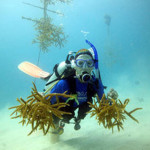
Join your local garden club, help ”plant” corals
Working with corals might not be the first thing that comes to mind when you think about a local garden club. That is however exactly what you would be doing if you where a member of the Garden Club of the Upper Keys. They are trying to help restore corals in the local area by propagating and relocating corals.
“Gardening underwater? Yes, we’re helping to restore our precious coral reefs,” says club President Marilyn Rogers.
The Garden Club of the Upper Keys is indeed a garden club in more than only name and is a member of the Florida Federation of Garden Clubs. Florida Federation of Garden Clubs has 13,000 members in 200 clubs and have chosen to welcome the Key Largo-based Coral Restoration Foundation as a yearlong member. The fundation is helping fund the restoration work on a designated reef site on French Reef in the Upper Keys
The members of the two usually unrelated disciplines say that there are many similarities between regular gardening and ”underwater gardening”. (like most reef keepers already now)) The “right plant, right place” is as an example an important adage in both types of gardening. The process of producing and replanting plants in your garden is also rather similar.
“First the coral is grown in a nursery until it is strong enough to be attached to the reef,” Rogers said. “The branching corals are then gathered and moved to the protected staghorn or elkhorn coral areas. Site selection and preparation are key elements for success. The gardener diver decides where to site the coral, in what position and preps the spot. The corals are attached with special marine epoxy.”
To find out more, go to www.coralrestoration.org.
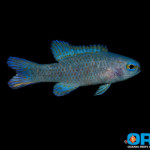
Captive Bred Randall’s Assessor available from ORA
ORA has released captive bred Randall’s Assessor to all of its resellers. The fish is now being shipped around the world and you might see the first fish in your local store later this week or early next week. The Randall’s Assessor is rather rare in the aquarium hobby and as such you can most likely expect these fish to be a bit more expensive than some other captive bred fish. Do not be surprised if these fish comes with a price tag of above USD 100.
ORA first acquired their Randall’s Assessor last year. The broad stock was acquired from Blue Harbor in Japan. ORA had almost immediate success with this species, something that shouldn’t be a surprise considering that ORA now have bred all known and kept assessor species. In December 2012 ORA announced that they had the first batch of fry going through metamorphosis and that they were about to change the focus of the breeding effort to ramp up numbers so that they could be released to the public. Something that they now, a mere 10 months later has been able to achieve. This feat was made a little bit easier by the fact that the Randall’s Assessor is a nest spawning species that produce large nests and quickly reach sexual maturity.
Randall’s Assessor is an excellent addition to most aquariums due to its relatively small size and its calm behavior.
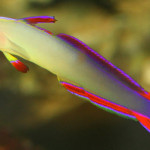
Exquisite firefish, Nemateleotris exquisita
A new species of firefish, the Exquisite firefish, Nemateleotris exquisita has been scientifically described. The new species is very similar to the purple firefish but with an to me even more intense coloring. It also grows larger that the purple firefish. The body of the Exquisite firefish is lined with purple and red. There is however no description that could make this little gem justice so it is better that you just take a look at the picture above. I welcome everyone to try to formulate a good description that captures the essence of this stunning fish and post it as a comment below.
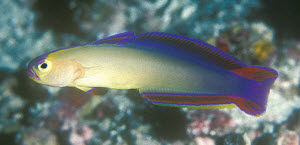
Hybrid between the exquisite and the purple firefish
The new species hails from Mauritius, Kwazulu-Natal,the Red Sea as well as the the Thai coast of the Andaman Sea, and the Andaman Islands. It was described from specimens that had been collected in rather deep water around Mauritius, Kwazulu-Natal and in the Red Sea. The new species is known to breed and spawn hybrids with the purple firefix. This is a relatively common occurrence in the wild. (in comparison to other hybrids).
This species might already have been imported as Purple firefish but there is no way to know for sure at this time. The fish that is being imported as purple firefish will in the future most likely be divided into a number of different species.
To me it seems certain that we soon will see this species in the trade imported from the Maldives and perhaps also the Red Sea. It will likely be a little bit more expensive than the purple firefish due to its initial rarity and due to them being harder to catch than the purple firefish since they live in deeper water.
Keeping the Exquisite firefish in aquarium
Basic info
- Family: Gobiidae
- Minimum Tank Size: 20 gallons
- Care Level: Easy
- Temperament: Peaceful
- Reef Compatible: Yes
- Temperature: 72-78° F
- dKH: 8-12
- pH: 8.1-8.4
- sg: 1.020-1.025
The Exquisite firefish, Nemateleotris exquisita can be kept in the aquarium in much the same way as the purple firefish and if you successfully kept purple firefish you should not have any problems keeping the Exquisite firefish. There are however a couple of things to remember. The Exquisite firefish grows larger than the purple firefish and will therefor need a larger tank. A 10 gallon tank could most likely work but we recommend giving it at least a 20 gallon tank so it has more space to roam around.
It is important that you provide the Exquisite firefish with enough suitable sized caves that they can retreat to when they feel threatened. It is a reef safe species and can be kept with mos other calm reef species. Avoid keeping them with very aggressive species.
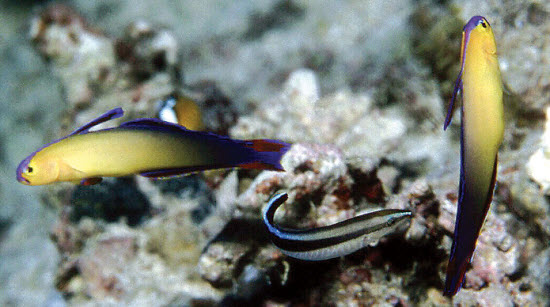
In the wild at 220 ft / 68 m deep
If you want to know more about this species i recommend that you the report that described the species:
Nemateleotris exquisita, a new microdesmid fish from the Indian Ocean
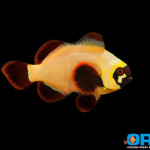
ORA Introduces the Gold Nugget Clownfish to market
The Gold Nugget maroon clownfish from ORA was first seen at Aquarama 2013 in Singapore. Now the production of this strain of clownfish has reached levels that allows ORA to release them on the market and they are now available to all ORA customers. Talk to your local reef store and ask them to bring some in if you want one.
The Guld Nugget Clownfish is a further development of the Goldflak maroon clownfish that ORA released September 2012. They where not a intentionally developed strain but rather a byproduct from increased gold flake clownfish production. When ORA started to increase production of the goldflake clownfish they discovered unique fry that were solid white and resembles Platinum percula clownfish but that develops a golden hue as they matures.
When young these gold nugget clownfish has a mostly white body with red and varying shades of red and maroon on the fins as well as the face. Some gold nugget juveniles will feature white on their face or even an tear drop under their eye. (should we guess that we will see tear drop clowns in the future?). The juveniles turns gold as they mature. When this happens depends on a number of different factors such as diet, habitat and lighting. They may start to turn gold after only 4-6 months but in most cases it takes more than a year for them to turn gold.
The Gold Nugget clownfish features a behavior such as you would expect from a maroon goldfish. They are in other words rather hardy and can be aggressive.
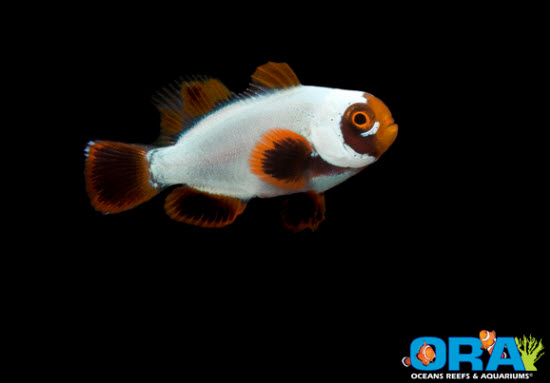
A juvenile gold nugget clown. Notice that white platinum hue in this juvenile fish. It takes from 4-6 month to more than a year for them to start to turn gold.
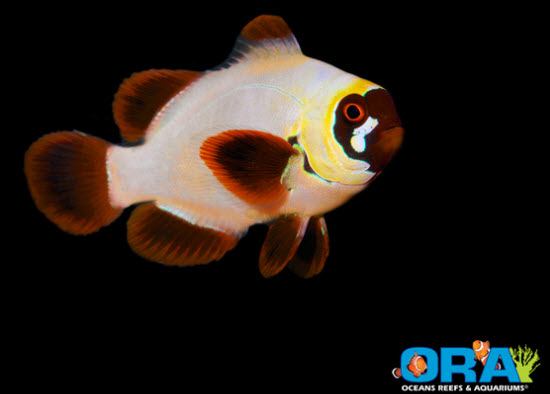
This specimen has just started to turn gold and you can start to see how it will look as an adult.
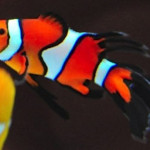
Introducing the Long Finned Clownfish
I guess we all knew that it was only a matter of time until we would see this, a long finned Ocellaris Clownfish. The fish was found in a batch of fry at Sustainable Aquatics breeding facility where marine biologist Matthew Jolley thought it looked odd as a young fish and separated it from the others to prevent it from being beaten up or killer. It was being severely bullied and was injured. The parents had produced many thousands of fry but this is the first long finned fry that has been spotted.
The young long finned male has healed up and been paired with a wild caught larger female (to garantee genetic diversity) and they seem to have bonded well. They have started spawning and Sustainable Aquatics is expecting their first batch of fry any day.
It still needs to be seen whether or not the long finned ocellaris breed true but there is reason to be believe that he may and if this is the case it will likely not be long until we start seeing this long fined clownfish type in the stores.
The reason that it is likely that he breeds true is that the trait likely is dominant or partially dominant; most long fin mutations in fish are. If this is the case in the ocellaris clown fish than we can expected to see long finned versions of most color morphs as the trait get bred into existing lines.
Read Sustainable Aquatics facebook announcement here.